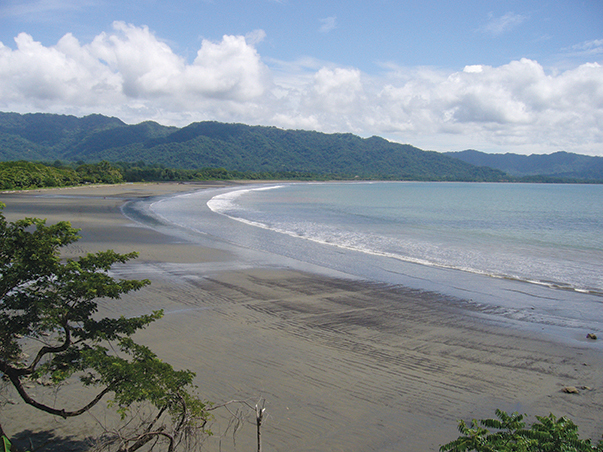Surf, sand and sailing in Central America’s jungle playground (published April 2015)
We pulled into Bahia Santa Elena, just past the Nicaraguan border, late on a Friday morning. The first official port of entry was Playa del Coco, 30-miles down the coast. Although we probably could have made it in time to check in later that day, we knew better than to bother the customs officials on a Friday afternoon. There was barely a ripple on the water in the large shallow bay; it was vacant except for one other boat. We found a private corner to tuck into and threw the hook.
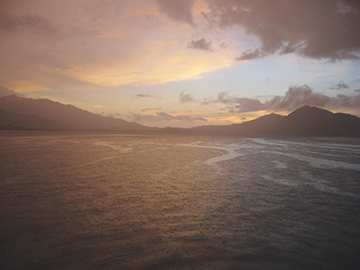
Our trip from Mexico was a shakedown for both us and the boat—a mock-up for our voyage from Panama west across the South Pacific later that year. It was our first long passage out of the sight of land on board Kate and it had taken us 10 days to sail 660 miles.
The Gulf of Tehuantepec was windless, despite its reputation for having sudden, strong winds funnel through the area. But as we neared Costa Rica, we sailed into days of violent squalls. The thunder was so loud I wondered if the rig was coming down and caught myself ducking with my hands over my head. The pitch-black night was punctuated by blinding bolts of lightning that often struck the water nearby. We watched as their fiery edges danced to an audible crackle of electricity. The wet, gray days were spent trying to dodge patches of driving rain and catch the fickle winds. It seemed like we sailed in circles for hours trying to avoid the worst of the weather. We were mentally and physically spent and I was looking forward to spending a quiet weekend licking my wounds and catching up on sleep.
Standing on the bow watching the anchor set, I was serenaded by the exotic melodies of unseen birds and the strange and primal barks of the howler monkeys resonated fiercely through the forest. That evening, the lush green mountains that surrounded us wore a delicate shawl of fog as we watched the sunset through a veil of pink. I felt safe, safe in the embrace of Costa Rica.
When we arrived in Playa del Coco a few days later there were no questions about our extended time at sea, even though we had racked up twice the amount of days as a typical passage should have taken. It took two days to track down the Port Captain, which didn’t seem to surprise anyone but gave us ample time to explore.
The beachfront town was a casual collection of restaurants, backpacker hostels and trinket shops. In the cool of the morning the howler monkeys roamed the quiet streets while locals sat sipping coffee. The International airport in Liberia was 30 minutes away by car, which meant the town relied heavily on tourism. But it would be well after noon before the young tourist crowd, looking rather wild themselves, crawled out to face the day. After our stunningly beautiful, uninhabited introduction in Bahia Santa Elena, it was an abrupt change of scenery.
The anchorage was also busy. An assortment of fishing boats crowded one corner, charter boats moved around daily and a steady stream of visiting yachts flowed in and out of the bay. The weather was settled, the skies were blue and after four days we were checked in and stocked up—it was time to get back to the jungle.
THAT HORRIBLE NOISE
We meandered a few miles south to a small heart-shaped bay called Guacamaya where we spent a lovely time enjoying the clear water, good snorkeling and beautiful sunsets. We were pulling up the anchor, ready to sail farther down the coast when I shifted into gear and heard a horrible ChaThunk noise. You didn’t have to know much about engines to know it was a kind of noise that sounded like trouble. Big trouble.
The anchor went back down and the investigation began. The transmission seemed to be engaging properly but Steve was unable to turn the engine over manually. We feared the worst, full engine seizure, and started weighing our options.
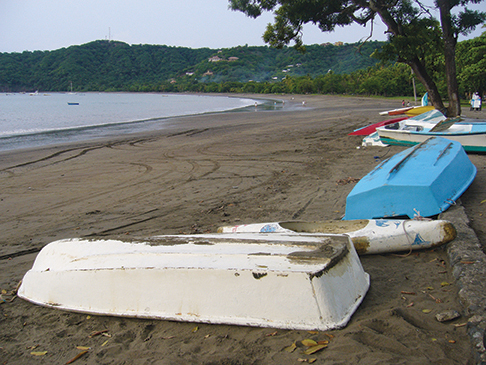
We decided to return to Playa del Coco, at least we would have access to the airport if we needed to fly in parts and we knew the anchorage well enough that we felt comfortable going in under sail. After nosing out of the bay we found barely enough wind to fill the gennaker, the air was light but the mood was heavy. As we ghosted along the coast the boat was draped in serious consideration: Steve wracking his brain trying to fix the yet undiscovered problem, me wondering what I could possibly do to help.
The engine problem seemed monumental. Somehow we had to lift the engine to drop the transmission…while we were anchored off a small Central American beach town. Miraculously, we found someone who lent us a rusty A-frame that fit inside the cabin perfectly. All we had to do was lug it through town and drag it down the beach at low tide.
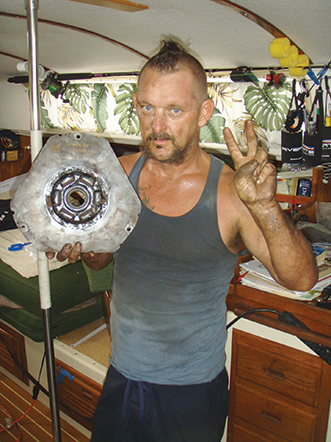
After removing the gearbox the problem was clear; the flex plate that connected the transmission with the engine had exploded, jamming shards of metal in the fly wheel. Over the next four days we worked tirelessly, crossing our fingers that the calm weather would hold. We woke up knowing that we’d spend the day hot, dirty and increasingly frustrated, and that fresh water and power would be in short supply.
It was exhausting. Steve fielded my curious questions with unending patience and good humor. Never one to shy away from getting my hands dirty, I was proud to be nominated “Chief Passer of Tools and Holder of Important Parts.” At the end of the day my fingernails were black despite several rounds of scrubbing, but I didn’t care. They were a sign of our accomplishments, our teamwork and perseverance. I wore them to town as a badge of honor.
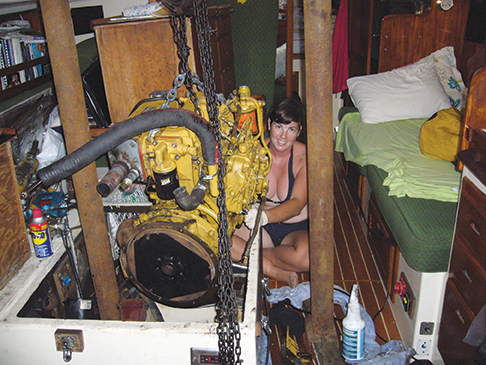
Thinking we had our problem solved, we stocked the fridge once more and started south again. We bypassed the pretty heart-shaped bay, not wanting it to be our undoing once again, and headed for the well-known town of Tamarindo.
SURF’S UP
It is common to see several surfboards strapped to the rails of sail boats in Costa Rica, but ask people about their favourite anchorage and you’ll often hear words such as rolly, washing machine, uncomfortable and sleepless. Long beaches, big tides and the exposure to the Pacific Ocean westerly swell are what make Costa Rica famous for its incredible surf spots—beach breaks in particular. Tamarindo is one of the most popular surf towns in the whole country, with several spots along the beach providing opportunities for experienced and novice surfers alike. Thankfully, when we arrived the waves were small because as a special birthday treat, Steve bought us surf lessons. After all our recent engine troubles we were ready to have some fun.
We got our boards and a brief lesson onshore before heading out into the surf. After paddling around in what felt like the crowded kiddie section I finally caught a wave. It only lasted a few seconds but I suddenly understood what all the fuss was about. I pictured myself as a surfer chick carving up a long crashing pipeline, just like in the movies. In reality I was riding a baby wave but just before I stepped off the board I turned towards Steve and pumped my fist in the air, whooping a big “YEAH!” before falling backwards into the water. I was surfing at a world class surf beach in Costa Rica. It was a pinch me moment and I was going to enjoy every minute of it, even if I looked like a damn fool doing it.
Being renowned for world class surf beaches translates into cruising terms as challenging beach landings, dragging the dinghy up endless stretches of wet, soft sand and guaranteed wet rides home. At some beaches, the surf really kicks up at high tide and at others it is active at low tide. On trips ashore we adopted the ritual of sitting under the palm trees and watching the surf when we were ready to go home. Sipping a cold beer to bolster our confidence, we counted wave sets, watched for a flat spot to appear and waited for the perfect moment to launch the dinghy. Our strategy worked all but once when we tried to get off the beach at Playa Flamingo in front of an audience of sunburnt tourists. The outboard didn’t start on the first, or second pull, and we got caught in the breaking waves and capsized the dinghy. Thankfully we had the forethought to have our belongings in waterproof bags, so it was only our pride that got damaged, and that was mostly just water logged.
Just before we pulled into Herradura, home to the luxurious Marina los Sueños, our engine started acting up again. We had been using it gingerly and mostly sailing for the past few weeks, hoping that our repair would hold. We could get by with collecting water, since Costa Rica is a tropical rainforest, it rained almost every afternoon, but we needed to charge the batteries. Thankfully, when the flex plate failed again it didn’t jam the engine. We didn’t have propulsion but we could run the engine and make power.
Our decision was to just keep sailing. We were enjoying ourselves too much to let a little problem like no engine get in our way, so we continued south slowly. When there wasn’t enough wind we drifted and to get in and out of anchorages, we tied our trusty dinghy at mid-ships and pushed Kate along with six horses of outboard power. Our decision required teamwork, patience and a positive attitude. It was one of the best choices we ever made.
COSTA RICA DISCOVERED
It is estimated that Costa Rica is home to five percent of the Earth’s biodiversity, and getting to see some of the amazing creatures that live there was as easy as stepping ashore. From a quiet anchorage just south of the town of Quepos, we walked to Manual Antonio National Park, a well-publicized tourist attraction, but well worth the visit. We hired a guide at the gate and were a little suspicious when his telescope immediately found an assortment of small lizards and a well-camouflaged sloth. We wondered if it had all been staged, but he quickly won us over with his vast knowledge of the flora and fauna, his witty sense of humor and his obvious deep affection for the animals.
Our last stop for fun was Bahia Drake, a protected bay tucked into the northwest corner of the Osa Peninsula. Touted as one of Costa Rica’s most isolated destinations, it was quickly named as a favorite spot by all of the cruisers we spoke to.
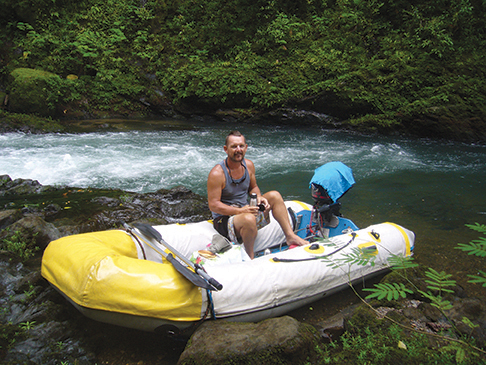
In the quiet of the morning, Steve and I would pack a thermos of tea and a light breakfast and jump into the dinghy. We followed a small river that snaked into the jungle and when it became too narrow, we turned off the outboard and drifted back down stream. We enjoyed our picnic while watching flocks of red macaws play in the trees and listening to the back and forth call of the toucans. We saw monkeys, lizards, fish and a shy river otter while enjoying our weeklong private jungle paradise, but eventually it was time to face our demon. We headed to the town of Golfito, our last stop before the Panamanian border.
DEFEATING OUR DEMON
Bahia Golfito is a large deep inlet that is accessible by a small channel from the Golfo Dulce. Almost completely surrounded by rolling, tree covered hills it is a bustling little town and home of Land Sea, a small but very helpful marina run by a couple of ex-pats. Anchored just outside the little mooring field, we were able to use the dinghy dock and all the shore side facilities, including workshop, showers and laundry, for a small daily fee.
Protected from the winds and the open ocean swell, we once again tackled our flex plate problem, this time using the Land Sea Internet services and mailing address to have a new one delivered from the U.S. While we waited for our part to arrive we caught up with all the boats we had met during our adventures down the coast, soaked in the local scene and readied for our departure to Panama. It was good to be in familiar company again; to have a morning yoga date and people to share our daily struggles with over afternoon beers, icy cold from the honor bar fridge.
As we sat in the clubhouse, listening to the afternoon rain and looking out over the anchorage, I was glad that we had taken our time to get here. Our engine problems had forced us to slow down, to think outside the box and to sail the route less traveled. They showed us how to work as a team and how to conquer our obstacles.
At the end of our Costa Rican odyssey, we knew one thing for sure; we were not going to be making our way across the Pacific to French Polynesia that year. There were too many places to stop, too many unexpected adventures to have. Maybe the famous, laid back “Pura Vida” attitude had rubbed off on us. Or maybe I had just finally learned that nothing was ever going to be perfect, but that didn’t mean it wasn’t going to be okay.
Heather Francis is originally from Nova Scotia, Canada and has been sailing with her partner, Steven Hertik, on board their Newport 41 Kate since 2008. They have spent the last three years in the South Pacific. To follow their adventures log onto www.yachtkate.com.
COSTA RICA
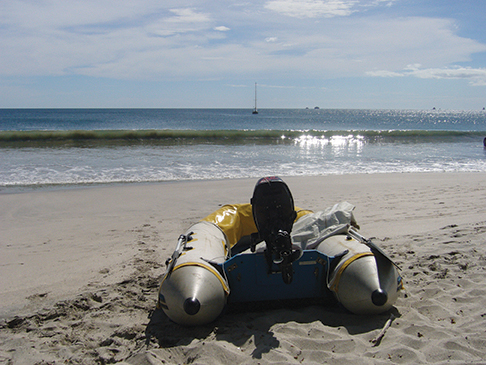
Costa Rica might be famous for its laid back Pura Vida attitude but it is also infamous for its petty theft. Although we did not experience anything first hand, it remains the only place in six years that we regularly chained the dinghy up when leaving it on the beach. While we were there we did hear of an outboard being lifted off the rails in the middle of the night and of fuel hoses disappearing on shore. Like most places, general care and attention should be paid with valuable items, and common sense used when leaving the boat or dinghy unattended. It only takes a moment to raise the dinghy at night or to ask someone in the anchorage to keep an eye on your boat if taking extended trips ashore.
Our most used cruising guide while sailing Costa Rica was Explore Central America 2 by Eric Baicy and Sherrell Watson. This digital guide is packed full of useful tips about anchorages as well as things to do and find ashore, and you can update your download as new information is added. These two have not only compiled information from other sailors but have meticulously verified GPS waypoints, charts and useful check in/out information while sailing on their own boat, S/V Sarana. They are available as PDF files or eBooks on their website, www.svsarana.com. If you find a pirate copy or want to share your copy with fellow cruisers, please log onto their site and pay the small download fee, all their hard work deserves to be rewarded.















